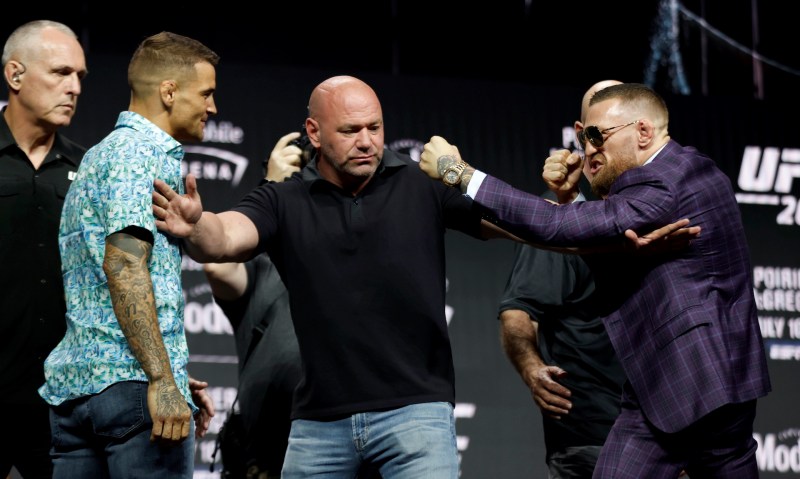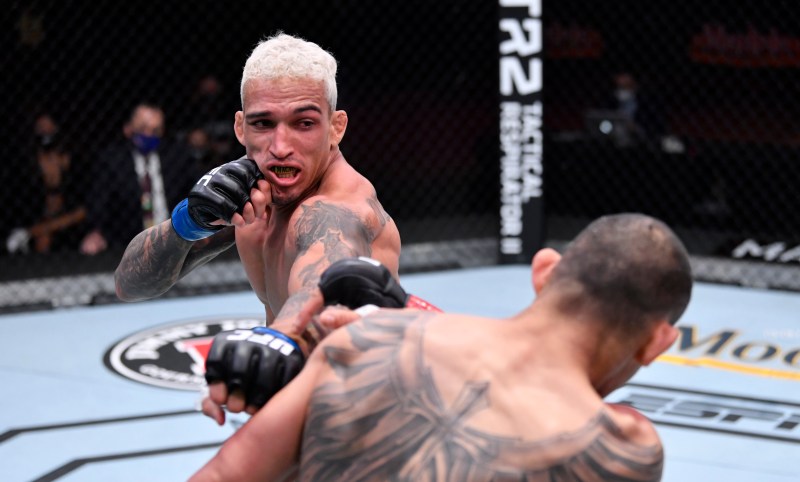In the large and growing world of mixed martial arts, two names loom large above the rest: The Ultimate Fighting Championship and Bellator. Both of these fighting leagues have done a lot to promote and popularize MMA in the U.S. and around the globe — even people who don’t follow combat sports have at least heard of the UFC — and whether you’re a seasoned fight fan or you’ve just recently become interested in these primal (and often bloody) contests, these are the top two promotions that you need to be familiar with. Here’s everything you need to know about the UFC and Bellator, and a few subtle ways in which they differ.
The Leagues
The Ultimate Fighting Championship was founded 28 years ago and is the league that put mixed martial arts on the map. Its stated purpose was to pit different schools of martial arts — boxing, Muay Thai, Jiu-Jitsu, Judo, wrestling, Karate, and so on — against each other in order to determine which was truly the best. It didn’t take long for fighters to start adopting techniques from multiple fighting styles, effectively creating MMA as we know it today: A potent cocktail of stand-up kickboxing and on-the-ground submission wrestling.
The league’s first event was held in 1993; since then, more than 500 UFC gatherings have taken place. Dana White became president of the company in 2001, and under his leadership, the UFC has grown into the biggest mixed martial arts organization in the world, drawing in billions of dollars, millions of fans around the globe, and the best fighting talent that MMA has to offer. The promotion continues to grow in popularity and shows no signs of slowing down any time soon.
Related
Bellator is a newcomer to the MMA scene (at least in comparison to the UFC). Founded in 2008 by American businessman Bjorn Rebney, the 13-year-old organization stands in the UFC’s massive shadow but has nonetheless managed to quickly grow into a large and respected MMA promotion in its own right. Over its relatively short history, Bellator has expanded to become the second-largest mixed martial arts league in the U.S. and possibly in the world, and with Strikeforce founder and former martial artist Scott Coker at the helm of the ship since replacing Rebney as CEO in 2014, it looks as if the league is only going to continue on its upward trajectory.
The Rules

When mixed martial arts first became a thing in the ’90s, it was something of a free-for-all. Early matches didn’t have any hard rules or even weight classes (that was much of the appeal, admittedly), and while that sounds good on paper, it was a different story in practice. Fights began to drag on for far too long when neither fighter was able to clinch a knockout or submission, resulting in rather boring slogs that annoyed the fans. It soon became clear that while the bloody chaos of MMA was a big draw, it needed some structure to keep the show moving.
In 2000, the foundations were laid for what is now the Unified Rules of Mixed Martial Arts. This ruleset implemented official weight classes, medical standards, and a regimented schedule, mandating that each fight would feature three five-minute rounds for non-title bouts, up to five rounds for championship matches, and a one-minute break between rounds. This capped the maximum length of fights at 30 minutes to keep the action flowing. Of course, plenty of matches still end early in the event of a knockout or a submission, but for bouts where both combatants “go the distance” and stay on their feet for all five rounds, a panel of judges determines the winner. Both Bellator and the UFC adhere to their own slightly adapted versions of the Unified Rules of Mixed Martial Arts.
Recommended Reading
- How Long is a UFC Fight?
- How Much do UFC Fighters Get Paid?
- What is UFC Fight Night?
- Is UFC Fight Night Free?
All fights take place in a caged arena, and as the sport has matured, the ruleset has become more polished as well. In the early days of MMA, most strikes were legal and the contests were essentially “no holds barred.” Today, however, certain strikes and holds are not allowed and will result in penalties up to and including disqualifications, overturned victories, suspensions, and even stripped championship titles. Groin strikes, knee strikes to the head of a downed opponent, hair grabbing, and eye pokes are a few examples of illegal moves (they still happen from time to time, although usually by accident). A referee is also present in the ring to moderate each fight. There are sometimes minor differences between local commissions and other regulatory bodies for small details, such as what constitutes a “downed” opponent, but these are not typically league-specific.
Both the UFC and Bellator also adhere to state anti-doping standards (usually set by the state athletic commission that governs the local in which a fight is taking place), with stiff penalties doled out for fighters who don’t pass the regular drug tests. This is a fiercely competitive sport with a lot of money getting thrown around and the temptation to cheat with illegal performance-enhancing substances is definitely there. A few notable MMA fighters who have fallen to this temptation in the past include Jon Jones, Josh Barnett, and Royce Gracie. Nate Diaz also failed a drug test for marijuana, which, while certainly not a performance enhancer, nonetheless caused the Nevada State Athletic Commission to declare his Pride 33 victory over Takanori Gomi a “no contest.”
The Fighters

It’s no secret that pretty much every fighter who wants to go professional in the world of MMA aspires to sign with the UFC at some point and to eventually make it onto the main card of a UFC event — and hopefully to a championship belt. Only a select few combatants ever get that far, but the UFC continues to draw in the hottest talent. That dominance isn’t as strong as it used to be, however; Bellator has some great fighters on its roster as well and currently commands some of the best light heavyweights in the world with stars like Vadim Nemkov, Ryan Bader, Anthony Johnson, and Yoel Romero.
That said, the UFC is still where the real clout (and the real money) awaits, and fighters who are on their way up the ranks typically move from Bellator to the UFC rather than in the opposite direction. The flip-side of that coin is that UFC fighters who get dropped from the league often end up signing with Bellator, as was the case recently with Anthony Johnson and Yoel Romero. The UFC roster also boasts the biggest stars: Even people who aren’t into MMA are familiar with names like Conor McGregor, Brock Lesnar, and Ronda Rousey — all UFC alumni. Many UFC stars spent plenty of time busting their knuckles in Bellator, as well. A few noteworthy Bellator alumni who later went on to fight in the UFC include Jorge Masvidal, Alexander Volkov, Eddie Alvarez, and Ben Askren.
So What’s The Difference?
Frankly? Not much. Both are the biggest MMA leagues in the U.S. (and the world), both feature top-tier talent, both draw large audiences, and both employ similar rulesets — even if the UFC commands the larger market share of the two. Nevertheless, there’s no denying that Bellator plays second fiddle to the UFC, which is the most successful mixed martial arts organization out there and will likely remain so for the foreseeable future. The UFC did put MMA on the map, after all, and has a 15-year head-start over Bellator. Bigger budgets for fighter purses and promotions also keep the UFC at the top of the heap.
We mentioned that Bellator and the UFC have both adopted the Unified Rules of Mixed Martial Arts with some slight modifications. Whereas the Unified Rules dictate that only championship fights are to be sanctioned for five rounds, all UFC main card bouts are slated for five rounds instead of three. Bellator adheres to the Unified Rules, however, meaning that only championship bouts run for five rounds, all others for three.
The arenas are also somewhat different, something you’ll notice at a glance. The UFC uses an eight-sided caged ring, the aptly named and instantly recognizable “octagon,” that is 30 feet in diameter with a 750-square-foot fighting area. Bellator pits fighters in a circular cage that measures 36 feet in diameter with 1,018 square feet of fighting space, more than 25% larger than that of the UFC’s.
All in all, if you like MMA, then the UFC and Bellator are the two U.S. leagues to pay attention to, and the minor differences between the two shouldn’t put you off on either one. Both promotions run many events each year to give fans plenty of entertainment to chew on. The UFC hosts fight cards weekly and at least one PPV event each month, while Bellator runs at a more moderate operational tempo with one to four monthly cards and less frequent pay-per-views. ESPN holds exclusive broadcasting rights to UFC fights (with ESPN+ being the only outlet for live UFC PPV shows); Bellator, being a subsidiary of ViacomCBS, airs via the CBS Sports Network and Showtime.



